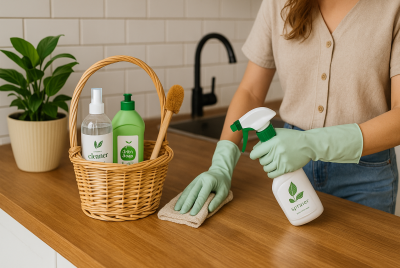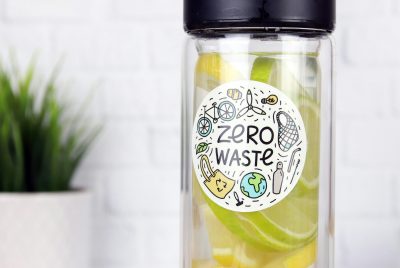Eco-Home Renovation: 10 Non-Toxic Decor Swaps for Cozy Living
We may earn a commission for purchases made using our links. Please see our disclosure to learn more.
You want a warm, beautiful home—not one laced with hidden fumes from paints, glues, and synthetic finishes. The problem is that quick makeovers often invite volatile organic compounds (VOCs) and lingering odors you only notice after the weekend rush. That’s where a smarter Eco-Home Renovation plan helps. Instead of guessing, you’ll sort upgrades by room and material, use research-backed choices, and phase projects so they’re budget-friendly. The result is a home that feels calm, looks elevated, and treats your air as carefully as your design.
Why VOCs Matter in a Cozy, Non-Toxic Home
You can swap every candle, rug, and wall color in your home—but if the air you breathe is laced with hidden chemicals, it’s not really cozy living. This is where volatile organic compounds (VOCs) become relevant.
According to the EPA’s overview of indoor air quality and VOCs, VOCs are gases released from everyday household items like paints, adhesives, furniture finishes, and even some cleaning products. Indoors, VOC levels can be two to five times higher than outdoor air, and during activities like painting, those levels can soar up to 1,000 times higher. These emissions don’t just smell bad—they can cause headaches, dizziness, irritation, and long-term health issues when exposure builds up over time.
The takeaway? A truly eco-home renovation goes beyond choosing earthy tones and bamboo textures—it’s about protecting your indoor air quality as much as your style aesthetic.
A 2015 ScienceDirect study on low-VOC and zero-VOC paints found that even some “eco” paints still release measurable VOCs after application. The study emphasized that while low-VOC products are a great step forward, ventilation is still key. Fresh air circulation helps clear residual gases and keeps your living space breathable and safe.
By keeping VOCs in mind, each of your non-toxic decor swaps—from furniture to finishes—doesn’t just look good, it helps your home feel healthier, fresher, and truly cozy.

10 Non-Toxic Decor Swaps
Walls & Paint
An Eco-Home Renovation starts with big surfaces, so wall finishes make the biggest air-quality difference. Walls dominate your surface area, so the paint choice matters. Choose low- or ultra-low-VOC paint, then keep windows cracked and fans running while it cures. If you love subtle texture, limewash or clay plaster adds velvety depth without the plasticky sheen of some acrylics. Testing on a removable board first lets you preview color and let the sample off-gas before it ever reaches your walls.
Floors & Rugs
Natural fibers are an Eco-Home Renovation staple—jute or wool + a rubber pad beats PVC every time. When replacing flooring isn’t realistic, add a natural-fiber area rug in jute, sisal, wool, or cotton. Place it over a natural-rubber or felt pad, not PVC. You’ll soften echoes, warm up the space, and skip the mystery smells that sometimes come with synthetic backings. A quick airing in the sun freshens most rugs before they come inside.
Furniture & Built-Ins
Pressed wood can release more formaldehyde than solid wood. If you’re buying new, ask for solid wood or panels labeled ULEF/NAF (ultra-low or no added formaldehyde). If you already own composite pieces, sealing raw edges and undersides with a water-based, low-VOC topcoat slows emissions. Thrifted wood furniture is a bonus: it has typically off-gassed most of what it ever had.
Textiles & Windows
Soft goods touch skin and face daily light. GOTS-certified organic cotton or linen performs beautifully for bedding, throws, and curtains. Wash new textiles before first use to remove residues and soften the hand. For rentals, tension rods and simple metal or wood hardware avoid drilling and vinyl liners.
Kitchen & Dining
Heat and steam move air—and everything in it. Flip on the range hood whenever you’re cooking. Choose stainless steel or enameled cast iron over PFAS-coated pans. If painting cabinets, pick a low-VOC enamel and let it cure with cross-ventilation for several days. Solid-wood cutting boards finished with food-safe oil or beeswax beat synthetic boards for both feel and longevity.

Lighting & Ambience
If you love candlelight, use plain beeswax or simple plant-based wax with cotton wicks—and burn briefly with a window cracked. For everyday glow, warm-white LEDs layered in lamps and sconces feel cozy while keeping indoor particles low. Skip heavy room sprays; a pot of simmering citrus peels and cloves scents the kitchen without synthetic fragrance.
Adhesives, Sealants & Caulks
Those little tubes pack a punch. Choose low-VOC construction adhesive and caulk for everything from trim work to mirror installs. Cap tightly, store opened tubes in a sealed bag, and label the date so they don’t slow-vent in a closet.
Plants & Biophilia
Houseplants improve mood and help a room feel alive, even if they’re not a substitute for ventilation or filtration. Group a few where you rest or read. Then handle actual air management with a window crack, an exhaust fan, or a purifier when you’re painting or assembling furniture.
Air & Maintenance
Small habits carry your improvements further. Open windows daily when weather allows, especially after showers and cooking. Keep up with HVAC filters. For everyday wipe-downs, lean on gentler staples—this guide to eco-friendly products for cleaning covers simple swaps that support your healthier finishes.
Secondhand & Upcycling
Pre-loved pieces cut budget and off-gassing. Tighten wobbly joinery, sand lightly, wipe clean, and refinish with a water-based topcoat. Drawer organizers in unfinished wood or metal beat plastic bins and keep small spaces feeling calm.
How to Build an Eco-Friendly Home
Building an eco-friendly home means creating a space that is efficient, healthy, and sustainable. The goal is to lighten your environmental footprint, use fewer resources, and keep the home comfortable and healthy for the long haul.
Sustainable Planning and Design
The design stage determines how eco-friendly your home will be. Position the house to capture sunlight in winter and provide shade in summer. Allow natural airflow through well-placed windows and doors to maintain comfort without overusing air conditioning. Keep the design compact to minimize material use and energy needs. Choose a site close to public transport and amenities, and avoid building on sensitive ecosystems.
Use Eco-Friendly Materials
Choose building materials that are renewable, recycled, or locally sourced. Reclaimed wood, bamboo, or recycled steel offer durable and sustainable options. For insulation, materials like hempcrete, straw bales, or cellulose provide excellent thermal performance. Cool or green roofs help reduce heat and manage rainwater effectively. Indoors, low-VOC paints and natural or reclaimed flooring improve air quality and reduce exposure to harmful chemicals.
Maximize Energy Efficiency
Energy efficiency should be prioritized before adding renewable systems. Insulating walls, roofs, and floors keeps indoor temperatures steady throughout the year. A tightly sealed building shell cuts drafts and prevents wasted energy. High-performance windows limit heat transfer, while LED lighting and energy-efficient appliances cut electricity use. Smart thermostats and efficient HVAC systems further optimize energy consumption.
Integrate Renewable Energy and Water Systems
Renewable systems make your home more self-sufficient and environmentally responsible. Solar panels or solar water heaters can power and heat your home sustainably. Rainwater harvesting systems collect water for outdoor and non-potable indoor use. Greywater systems recycle wastewater from sinks and showers for irrigation, while low-flow fixtures help conserve water daily.
Eco-Friendly Landscaping
Your outdoor space supports the home’s overall sustainability. Choosing native, drought-friendly plants means far less watering. Strategically placed trees provide shade in summer and sunlight in winter. Permeable materials for driveways and walkways reduce stormwater runoff and improve groundwater absorption.
An eco-friendly home benefits both the planet and its occupants, offering a healthier, more efficient, and cost-effective way to live.
Recommended Products
Here are five simple product recommendations to kick-start your eco swaps—use them as a quick launch pad, and always double-check live specs, safety labels, and certifications before you buy.
- Bluecorn Beeswax 100% Pure Beeswax Taper Candles for occasional, unscented ambience.
- GOTS-Certified Cotton Throw Blanket for skin-contact comfort that washes clean.
- RUGPADUSA Nature’s Grip Natural Rubber + Jute Pad to pair with jute, sisal, or wool rugs without PVC.
- AFM Safecoat Polyureseal to seal thrifted wood projects with minimal odor.
- Temtop M10/M10+ Air Quality Monitor to sanity-check TVOCs and fine particles during projects.
Conclusion
A healthier, cozier home doesn’t demand a full gut renovation. It comes from ordering your moves: tackle the big surfaces, choose low-emitting materials, keep air moving, and add texture with natural fibers and thoughtful lighting. Weekend DIYs carry you forward without draining your budget, and a clear build roadmap turns bigger projects into a calm, documented process. Begin your Eco-Home Renovation with one small swap this week, then build momentum room by room. Your home will smell cleaner, feel quieter, and welcome you back every time you open the door.
FAQs
Are “low-VOC” paints completely odorless?
Not quite, though they’re far gentler than conventional options. Keep windows cracked and fans on while painting, and let walls cure before heavy use. Sensitive households sometimes prefer limewash or clay finishes for bedrooms.
How do I cut odors from new furniture?
Unbox in a garage or balcony, wipe surfaces with a damp microfiber cloth, and let the piece air for 24–72 hours. If it’s composite wood, sealing raw edges with a water-based topcoat helps. Bring it inside once the sharp smell fades.
Will houseplants clean my air?
They lift mood and make rooms feel alive, which is valuable. However, for actual pollutant control, use ventilation, kitchen and bath exhausts, and—during projects—a purifier with HEPA and carbon.
I rent. Can I still make non-toxic changes?
Yes. Choose removable solutions: tension-rod curtains in GOTS cotton, natural-fiber rugs with safe pads, beeswax candles for short sessions, freestanding wood shelves, and fabric-covered pinboards. All are reversible on move-out day.
What’s the simplest starting plan on a tight budget?
Adopt a ventilation habit after cooking and showers, change HVAC filters on schedule, refresh a small piece of furniture with milk paint, and switch daily cleaners to gentler basics.




